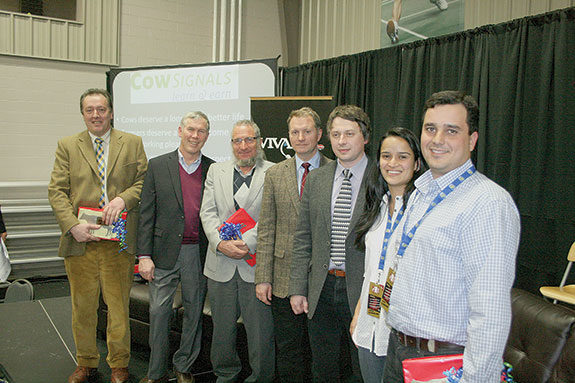In a first-of-its-kind global dairy summit, the Canadian Dairy XPO, held Feb. 6-7 in Stratford, Ontario, brought together dairy producers from five different countries to share their differences, similarities, challenges and opportunities.
Howell Richards from Carmarthen, South Wales, farms with his wife, Susan. About 20 years ago, they purchased 40 acres in West Wales. Since then, they have moved three times, owning three different farms. They are now farming 1,800 acres, 1,100 acres owned and 700 acres rented.
Their farm has grown from three cows to 2,150 milking cows and 1,000 youngstock. They have 23 full-time employees and milk cows in a 60-cow rotary parlour. Their herd average is 10,400 litres.
Piotr Romaszewski spoke on behalf of Jacek Wyrebski. Wyrebski is the managing director of Osieciny Farm in Poland. He took over after his father, who worked there for 40 years.
The farm was established in 1961 by the Polish government. Today there are 1,200 milking cows and 1,500 youngstock. The herd average is 11,700 litres per cow, with 3.9 fat and 3.25 protein.
In addition, the farm participates in research trials, mostly feeding studies, with the university. The farm owns 3,000 hectares of land, which is cropped as 1,000 wheat, 1,000 maize (corn), 700 rapeseed and 300 alfalfa.
Ana Paula Coelho Sekita Garcia and her husband, Leonardo Lopes Garcia, farm in southeastern Brazil. They began dairying in 2008 to reduce the cost of fertiliser on their vegetable farm.
They produce 900 hectares of carrots and 200 hectares of garlic each year. Right now they have 700 cows and 1,300 heifers with plans to grow to 1,500 milk cows.
From Ancaster, Ontario, David Loewith farms with his brother and nephew. They are milking 370 cows three times a day. They have 500 kilograms of quota and are a little bit over at the moment.
The Loewiths farm 800 acres, mostly custom harvested.
Willard DeGolyer, of Castile, New York, said he believes in using one set of equipment efficiently, so his farm milks 1,060 cows 24 hours a day in a double-20 herringbone parlour.
DeGolyer, his wife, his uncle and his daughter own the farm. Along with the help of 25 full-time and part-time individuals, they also raise 850 youngstock and grow corn, alfalfa and peas on 1,665 acres.
Challenges
RICHARDS: “One of the major challenges is farming under a TB (tuberculosis) policy,” he said. “That’s one of the main drivers for us to start rearing our own heifers.”
He used to purchase all replacements, 90 percent of which came from Holland. Now, badgers (a protected species in the United Kingdom) have been known to spread TB.
For the past five or six years, animals can no longer be sold from farm to farm, he said. Every animal sold has to go straight to slaughter.
In addition, every animal on the farm has to be tested for TB every six months, a process that takes his farm eight days to complete.
Other challenges Richards faces include land prices, cost of production and, with three children, succession planning.
ROMASZEWSKI: The government owns the farm, and there is a law that says that it cannot expand its production.
LOEWITH: Running a 135 percent stocking density, their facilities are “extremely overcrowded,” he said.
The farm is situated very close to the city and they have been working to get variances to build new buildings where they would like for them to be located. As part of that process, they had to purchase an existing house and seven acres.
A challenge for the Canadian dairy industry as a whole, he said, is growing its milk market.
DeGOLYER: Between the ethanol industry and the drought, he’s been sticker-shocked with grain prices in the U.S. DeGolyer has tried to adapt by harvesting hay in a single day to preserve the nutrients and by selecting corn varieties based upon digestibility.
Cost of production
GARCIA: Their cost of production is higher than other farms because they are raising a lot of heifers to grow the dairy. With the currency conversion, she calculated their cost of production at 47 cents and a gross income of 50 cents, leaving a 6 percent profit margin.
RICHARDS: At the moment, the UK is quite different than the rest of Europe, where it has a 13.9 billion-litre quota but is only fulfilling 12.1 to 12.3 billion litres.
For the last several years, it has had the lowest milk price in all of Europe, causing a huge exodus of dairy farmers. However, that exodus has created huge opportunities as well, he said.
The supermarkets have started to work with some farmers, offering them cost-of-production contracts. The supermarkets came up with 32.5 pence a litre for cost of production, allowing for four pence per litre family living costs.
“The average milk price the last month in the U.K. was 28 to 29 pence,” he said. “You can see why we’re not meeting quota.”
His cost of production is running about 24 pence a litre and he’s receiving 30 pence a litre for his milk. Richards said the milk price is expected to increase about two pence a litre in the next couple of months; however, he’ll also be setting a new 18-month feed contract on May 1 and expects that to increase one penny a litre.
“Something I’ve learned as I travel around to different countries is the higher the milk price, the higher the cost of production,” Richards said. “If you really want people to be efficient, lower the milk price.”
ROMASZEWSKI: The farm as a cost of production is 28 Euro cents per litre. More than half (55 to 60 percent) is feed costs, 13 percent is for labour and the rest toward energy, veterinary, fuel and building maintenance.
The farm receives about 33 Euro cents per litre for milk, which means it is earning about five Euro cents per litre.
LOEWITH: Including the cost of raising heifers and family labour, the Loewiths’ cost of production is 57 cents per litre. He said the farm might be top-heavy in management, but he believes his profitability comes from output per man rather than cost per litre.
DeGOLYER: He figured the industry averages 44 cents a litre, whereas cost of production for his farm is 41.5 cents per litre.
Land prices
GARCIA: In southern Brazil, there is no land available to buy, she said. Some say the price is around $15,000 per hectare with water access. The Garcias’ advantage is that they are able to use the same land they already own for vegetables.
The crops they use when rotating their carrot and garlic crops are what are fed to the cows. “We can minimize the cost of the land because we get more from it,” Garcia said.
RICHARDS: When he purchased his first farm 20 years ago, it was for £1,000 an acre. Eight years ago, another farm cost him slightly less than £3,000 an acre.
Two years ago, he bought a neighbouring farm for £6,000 an acre – and in the last eight months, the purchase of three nearby farms averaged £10,000 an acre.
ROMASZEWSKI: Since Poland joined the European Union, the prices of land have increased threefold, but it also depends on the region. In some regions, land sells for 6,000 pounds a hectare, but in others the price is 15,000 to 20,000 pounds a hectare.
At the same time, he said, it can be impossible to buy land because most farmers aren’t willing to sell it.
LOEWITH: In the last five years, land prices in southern Ontario have doubled. Some of that is a reflection of the tight quota policy, he said. Rather than investing in quota, producers are expanding their operations by putting money into land.
DeGOLYER: In his immediate area, land prices are 7,000 to 8,000 US$ an acre and have more than doubled the last couple of years. Elsewhere in New York, the price is roughly 4,500 US$. In the Corn Belt, he’s heard prices of 10,000 to 20,000 US$.
Breeding program
ROMASZEWSKI: Because the farm cannot increase its milk production, it is focusing on breeding. The farm is part of the Polish Holstein breeding program and sells approximately 100 heifers every year. It also sells 30 to 40 bulls to Polish A.I. stations and some embryos for transfer.
To increase the number of heifers available for sale, sexed semen is used on 80 percent of the heifer population.
GARCIA: To grow their herd, they are placing embryos in beef cows. They are also using sexed semen when breeding heifers.
They would like to improve the genetics of their herd, so they are doing embryo transfer fertilized with sexed semen in some of their milk cows. They are also purchasing cows from another region that has better genetics.
Their herd is 70 percent Gir and 30 percent crossed with Zebu. The crossbreds are being bred with pure Holstein embryos.
Unfortunately, their government doesn’t allow them to import cows from outside of South America; they can only import embryos and semen to increase the amount of Holsteins in their herd.
RICHARDS: Everything is bred to Holstein. The A.I. company selects a bull to use and the farm buys 1,000 straws. Once those are used, another bull is selected and another 1,000 straws are purchased.
Heifers are on an Ovsynch program. They are bred first-service to sexed semen and then run with beef bulls.
Next investment
ROMASZEWSKI: The farm is looking at robotic milking units. “We have quite a big problem with labour,” he said. “We have to hire people from different countries because Polish people are working in England and Germany.”
GARCIA: The next investment is in freestall barns because they don’t have facilities for all of their cows.
They also want to build barns for the heifers. Right now, the heifers graze the land between the irrigation pivots. During the summer months, when they receive more than two metres of rain they have a big problem with mud and flies.
They also hope facilities for heifers will help them reduce the age at first calving, which is currently at 27 to 28 months.
RICHARDS: He is planning to build another 500-cow barn but is running into problems with environmental restraints. He is also going to install fans and sprinklers in all cattle buildings.
A consultant claimed it would yield an extra litre per cow per day pay. If that happens, it will pay for itself in six months, he said.
LOEWITH: He wants to upgrade, renovate and build new facilities to eventually get stocking density down to one stall per cow for the bulk of the milking herd and 80 to 95 percent on close-up dry cows and transition cows.
This year, they are planning to build a new barn for heifers, an addition to the existing facility for cows and a new transition barn for hutches up to 7 months old.
One technology he said he’s most excited about is rumination monitoring, especially for close-up dry cows and post-fresh cows.
DeGOLYER: He is considering group housing for baby calves and an anaerobic digester. PD
PHOTO:
Dairy producers participating in the global summit at the Canadian Dairy XPO, from left to right, were Howell Richards, United Kingdom; Willard DeGolyer, U.S.; David Loewith, Canada; Jacek Wyrebski and Piotr Romaszewski, Poland; and Ana and Leonardo Garcia, Brazil. Photo courtesy of Karen Lee.










